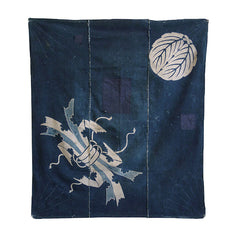A Resist Dyed and Sashiko Stitched Furoshiki: Noshi and Family Crest
ca. late nineteenth, early twentieth century
42" x 36", 106.5 cm x 91.5 cm
This is a graphically bold and technically interesting furoshiki, a traditional carrying cloth, from old Japan.
At first glance it appears that this is a tsutsugaki dyed fabric, meaning that the images were hand drawn with rice paste which resisted the indigo dye.
On a second look we can see that both images were resisted using a large stencil, and they are not tsutsugaki dyed.
The large, spider-like image is that of the auspicious noshi, a celebratory motif based on dried abalone: noshi is dried abalone that is stretched into long, ribbon like strips. The word noshi is a homonyn for the word “prolong,” so it became customary to include noshi with a gift as a symbol of longevity and prolonged happiness, so noshi is often used for wedding textiles, which this boro piece once was.
In the upper, right-hand corner we see a design of two oak leaves. This stylized design is a family crest or mon.
Now look at the four corners of this three-panel carrying cloth. Each is sashiko stitched in a stylized chrysanthemum design. And looking carefully you will realize that these corners were stitched on the undyed cotton, because the sashiko stitching is undyed on the resisted areas and dyed on the open areas. Really lovely.
This furoshiki contains some ingrained dirt, especially on the noshi, some surface abrasion and small holes, and three mending patches.
A wonderful, old textile.

